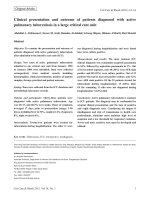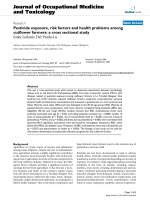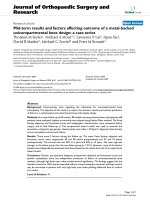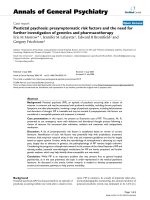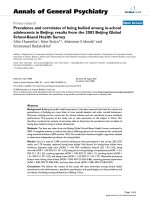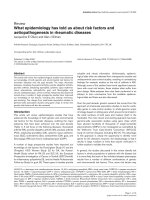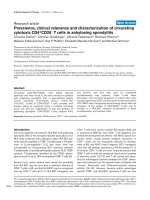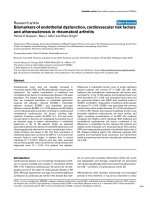Prevalence, risk factors and outcome of congenital anomalies among neonatal admissions in OGBOMOSO, Nigeria
Bạn đang xem bản rút gọn của tài liệu. Xem và tải ngay bản đầy đủ của tài liệu tại đây (962.13 KB, 10 trang )
Ajao and Adeoye BMC Pediatrics
(2019) 19:88
/>
RESEARCH ARTICLE
Open Access
Prevalence, risk factors and outcome of
congenital anomalies among neonatal
admissions in OGBOMOSO, Nigeria
Akinlabi E. Ajao1,2*
and Ikeola A. Adeoye1
Abstract
Background: Congenital anomalies (CA) are a major cause of neonatal morbidity and mortality, especially in
developing countries. Data on these anomalies are still poorly collated in developing countries. We aimed to assess
the prevalence, pattern, risk factors and outcome of congenital anomalies among neonatal admissions in
Ogbomoso Town, Nigeria.
Methods: A cross-sectional retrospective study in which a review of the records of all neonates admitted in the
neonatal unit of the Bowen University Teaching Hospital, Ogbomoso over a five-year period (January 2012–
December 2016) was undertaken. The occurrence rate and pattern of anomalies were determined, while factors
associated with the occurrence and outcome of anomalies were calculated with the odds ratio and 95%
confidence interval. Data entry and analysis were performed using SPSS version 21.
Results: CA were found in 67 of the 1057 neonatal admissions, giving a prevalence rate of 6.3%. Anomalies of the
cardiovascular and digestive systems were the most common. A higher proportion of babies referred from other
facilities had CA, and this was found statistically significant. There was no significant association between CA and
low birth weight, sex, maternal age or parity. The mortality rate among neonates with CA was 10.4%. Although, CA
was associated with reduced risk of neonatal mortality compared to those with other acute conditions, this was not
statistically significantly.
Conclusion: CA is a major indication for neonatal admissions in Ogbomoso. There is the need to establish a
surveillance system for CA and efforts should be made to raise awareness of the occurrence and risk factors of CA
in developing countries.
Keywords: Congenital anomalies, Neonates, Prevalence, Risk factors, Outcome, Developing countries
Background
Congenital anomalies (CA), or birth defects, are structural, behavioural, functional and metabolic disorders
that occur during intrauterine life and can be identified
prenatally, at birth or later in infancy [1, 2]. While birth
asphyxia, prematurity and infections are the leading
causes of adverse neonatal outcomes, congenital anomalies contribute significantly to neonatal morbidity and
mortality. An estimated 7.9 million children are born
with major congenital anomalies every year [3]. The
* Correspondence:
1
Department of Epidemiology and Medical Statistics, University of Ibadan,
Ibadan, Nigeria
2
Department of Surgery, Bowen University, Iwo, Nigeria
proportion of global neonatal mortality due to these defects increased from 3% in 2008 to 4.4% in 2013 [4, 5].
Unfortunately, more than 90% of congenital anomalies
occur in low and middle income countries (LMICs) [6].
Major CAs are defined as anomalies with significant effect on life expectancy and they occur in 2–3% of live
births and in 20–30% of still births [1, 7]. Their prevalence, however, varies with time and geographical location
reflecting a complex interaction between genetics and environmental factors [8]. They account for about 3% of live
births and 15–30% of paediatric hospitalizations in the
United States [7, 9]. In Sub-Saharan Africa, Ndibazza et al.
reported a prevalence of more than 7% in Entebbe,
© The Author(s). 2019 Open Access This article is distributed under the terms of the Creative Commons Attribution 4.0
International License ( which permits unrestricted use, distribution, and
reproduction in any medium, provided you give appropriate credit to the original author(s) and the source, provide a link to
the Creative Commons license, and indicate if changes were made. The Creative Commons Public Domain Dedication waiver
( applies to the data made available in this article, unless otherwise stated.
Ajao and Adeoye BMC Pediatrics
(2019) 19:88
Uganda and hospital-based studies from Nigeria have
shown prevalence ranging between 0.4 and 11.1% [10–13].
All organ systems within the body can be affected by
CA. The musculoskeletal system is the most often affected
system in studies that have focused on externally visible
anomalies [3, 8, 10, 14, 15]. In other studies, the cardiovascular and gastrointestinal systems have predominated [9,
16–18]. In previous studies from Nigeria, the gastrointestinal system has been the most reported [13, 19, 20].
Understanding the aetiology of CA is important in
prevention and in genetic counselling that may help in
eradication. Generally, the aetiology of birth defects remains unclear but is thought to be multifactorial. These
factors may be genetic (10–30%), environmental (5–
10%) or due to multifactorial inheritance (20–35%),
while 30–45% are unknown [7]. Infectious agents appear
to be the most important environmental factor in LMICs
[6]. Implicated maternal factors include age, lifestyle, illnesses during pregnancy, antenatal care, medication use
and non-use of peri-conceptual folic acid [1, 7, 14, 17,
21]. Parental consanguinity, previous miscarriages and
stillbirths, and inheritable congenital disease are other
important factors in the aetiology of CAs [14, 17, 21].
Mortality is very high among major CA in LMICs rising to 20–85% (as against less than 10% in high-income
countries) and generally, mortality is higher among infants with CA compared to normal births [6, 22–24].
Ninety-five per cent of deaths among children with CA
worldwide occur in LMICs [22]. A significant number of
survivors also suffer life-long disabilities, with birth defects accounting
for 25.3 to 35.8 million
disability-adjusted life years, worldwide [3, 6].
Despite the huge burden of congenital anomalies in
LMICs, there is still a dearth of comprehensive data on
these conditions as birth defects registries are absent [3].
There is significant under-estimation of CA in LMICs
due to non-presentation at health facilities,
under-reporting, deficient diagnostic capacity and poor
awareness [3, 25]. Prevalence studies are needed to establish baseline rates, demonstrate changes that occur
over time and give clues to aetiology [11]. This study
assessed perinatal and maternal factors that may be associated with the occurrence of these congenital anomalies. Outcomes of neonatal admissions with congenital
anomalies were compared with other neonatal admissions with other acute conditions to assess their relative
morbidity and mortality. This study may, therefore,
guide policy makers to increase surveillance of these
conditions and perhaps raise awareness of the impact of
these anomalies within overall neonatal mortality.
We aimed to assess the prevalence, pattern, risk factors and outcome of congenital anomalies among neonatal admissions in a Tertiary Hospital in a semi-urban
area, South-West, Nigeria.
Page 2 of 10
Methods
Study setting
This study was conducted at the Neonatal Unit of the
Bowen University Teaching Hospital (BUTH), Ogbomoso. BUTH is a faith-based tertiary institution, which
is located in semi-urban Ogbomoso, in Oyo State,
South-West
Nigeria.
The
institution
provides
multi-specialist care and serves as a major referral center
for hospitals within and outside Ogbomoso, including
towns in three states. The hospital was initially established as a general hospital in 1907 but was upgraded to
a teaching hospital in 2009. The neonatal unit provides
care for neonates delivered within and outside the hospital. However, babies requiring ventilator support and
other intensive care are referred elsewhere.
Study design
This was a cross-sectional study, conducted by retrospectively reviewing the medical records of all neonates admitted at the neonatal unit of BUTH over a five-year period
between January 2012 and December 2016. Ethical approval for the study was obtained from the institutional
research ethics committee. For the purpose of this study,
congenital anomalies were defined as structural defects
that were present at birth or identified during the neonatal
period, either clinically or through investigation modalities. Categorization of these anomalies was then done
using the European Surveillance of Congenital Anomalies
(EUROCAT) guidelines [26]. Perinatal asphyxia was defined as failure to establish breathing at birth (using the
WHO definition) and an APGAR score of less than 7 after
5 min of birth, while those with APGAR score of 3 or less
at this time were classified as having severe perinatal asphyxia. Preterm births were defined as deliveries occurring
before the completion of 37-week gestation. Obstetric
complications were defined as adverse maternal events
that are related to pregnancy, such as antepartum haemorrhage and pregnancy induced hypertensive disorders.
Data were collected on neonatal, birth and maternal characteristics, congenital anomaly status and the outcome of
the admission were obtained. Information on neonatal
characteristics obtained included: sex, age at presentation,
gestational age at birth, birth weight, and type of gestation,
place of birth and mode of delivery. Maternal factors obtained were age, parity, antenatal care, folic acid use, febrile
illness during pregnancy, self-medication and lifestyle variables, such as smoking and alcohol intake during pregnancy. The outcome variables were the status at discharge
(discharged, referred, discharged against medical advice and
died); and the mortality experience.
Statistical analysis
Data collected were analyzed using the SPSS version 21.
Categorical variables were summarized using frequencies,
Ajao and Adeoye BMC Pediatrics
(2019) 19:88
ratios and proportions, along with the 95% confidence
interval. Continuous variables were summarized using
mean, standard deviation, or median and interquartile
range (IQR). The prevalence rate of CA was calculated as
the proportion of neonates with CA among the total number of neonates admitted during the study period. Associations of neonatal characteristics and maternal
socio-demographic factors with congenital anomalies were
tested using the chi square statistic. Risk factors were
assessed using the binary logistic regression, and the odds
ratio and 95% confidence intervals were reported. Bivariate Cox regression analysis was used to assess variables
that were significantly associated with neonatal mortality
at p < 0.2, and significant variables were included in a
multivariate Cox regression analysis to determine the predictors of 28-day mortality among neonatal admissions at
p < 0.05. The level of significance was set at p < 0.05.
Page 3 of 10
Results
Figure 1 shows the distribution of all neonates admitted
based on the disease condition. Sixty-seven (67) of the
1057 admitted neonates had CA during this five-year
period giving an overall prevalence rate of 6.3%. The median age at presentation was 2 days (IQR, 6 days) and 36
(53.7%) were males. The mean birth weight was 2.5 (±
0.7) kg, and 58.3% of these neonates had birth weights
of 2.5 kg and above. Seventy-five percent of these neonates were delivered via the vaginal route and 38% were
delivered preterm (Table 1). Twenty-three patients
(34.3%) had associated perinatal asphyxia. The mean maternal age of neonates with congenital anomalies was
29.8 (±5.4) years. A higher proportion of patients referred from peripheral facilities had CA (8.9%) compared
to 3.9% of those delivered within the study location, and
this difference was statistically significant (p < 0.05). The
Fig. 1 Pie chart illustrating the distribution of neonatal admissions in BUTH between 2012 and 2016
Ajao and Adeoye BMC Pediatrics
(2019) 19:88
Page 4 of 10
Table 1 Neonatal & maternal socio-demographic factors of
study population by congenital anomaly status
Table 1 Neonatal & maternal socio-demographic factors of
study population by congenital anomaly status (Continued)
Characteristic
Characteristic
Congenital anomaly
Yes n (%)
No n (%)
Total n (%)a
p value
Missingb
Sex
576 (94.1)
612 (57.9)
0.475
Congenital anomaly
Yes n (%)
No n (%)
Total n (%)a
3 (6.4)
44 (93.6)
47 (4.4)
Male
36 (5.9)
Female
31 (7.0)
414 (93.0)
445 (42.1)
Ogbomoso
48 (5.9)
763 (94.1)
811 (76.7)
Total
67 (6.3)
990 (93.7)
1057 (100.0)
Outside Ogbomoso
16 (8.2)
179 (91.8)
195 (18.5)
Missingb
3 (5.9)
48 (94.1)
51 (4.8)
Maternal place of domicile
Age at presentation
0-7 days
59 (6.4)
870 (93.6)
929 (87.9)
8-28 days
8 (6.6)
114 (93.4)
122 (11.5)
Missingb
0 (0.0)
6 (100.0)
6 (0.6)
13 (5.1)
241 (94.9)
254 (24.0)
0.930
Gestational age at birth
Preterm
Term
21 (4.0)
503 (96.0)
524 (49.6)
Missingb
33 (11.8)
246 (88.2)
279 (26.4)
50 (7.1)
659 (92.9)
709 (67.1)
0.477
Mode of delivery
Vaginal
Abdominal
17 (5.1)
317 (94.9)
334 (31.6)
Missingb
0 (0.0)
14 (100.0)
14 (1.3)
20 (3.9)
494 (96.1)
514 (48.6)
0.228
Place of birth
Within BUTH
Referred
46 (8.9)
473 (91.1)
519 (49.1)
Missingb
1 (4.2)
23 (95.8)
24 (2.3)
13 (5.4)
227 (94.6)
240 (22.7)
0.001*
Obstetric complication
Yes
No
52 (6.6)
739 (93.4)
791 (74.8)
Missingb
2 (7.7)
24 (92.3)
26 (2.5)
5 (4.8)
100 (95.2)
105 (10.0)
0.518
Birth weight (kg)
< 1.5
1.5-2.49
20 (8.5)
216 (91.5)
236 (22.3)
≥ 2.5
35 (6.6)
495 (93.4)
530 (50.1)
Missingb
7 (3.8)
179 (96.2)
186 (17.6)
Yes
23 (7.1)
302 (92.9)
325 (30.7)
No
42 (6.0)
657 (94.0)
699 (66.2)
Missingb
2 (6.1)
31 (93.9)
33 (3.1)
≤ 20
4 (12.1)
29 (87.9)
33 (3.1)
21-35
31 (7.2)
399 (92.8)
430 (40.7)
0.420
Perinatal asphyxia
0.514
Maternal age (years)
>35
4 (4.9)
78 (95.1)
82 (7.8)
Missingb
28 (5.5)
484 (94.5)
512 (48.4)
Yoruba
60 (6.3)
895 (93.7)
955 (90.4)
Igbo
3 (9.7)
28 (90.3)
31 (2.9)
Others
1 (4.2)
23 (95.8)
24 (2.3)
0.393
Maternal tribe
0.678
p value
0.240
a
Column percentage; bMissing data excluded from analysis;
*Statistically significant
mothers were mainly of the Yoruba ethnic group (89.6%)
and 71.6% were domiciled within the town of study.
Anomalies of the cardiovascular system were the commonest anomalies in this cohort, occurring in 14 (20.9%)
of the neonates with CAs (Table 2). Three of the neonates
with cardiovascular CAs had multiple anomalies and the
predominant defect was ventricular septal defect observed
in six neonates. This was followed by anomalies of the digestive system occurring in 12 (17.9%), with anorectal
malformations being the predominant anomaly affecting
four of the neonates. Fifty-three (79.1%) of the anomalies
occurred in isolation, while 14 (20.9%) were syndromic.
Glucose-6-phosphate dehydrogenase (G6PD) deficiency, a metabolic CA, occurred in 50 (4.7%) of the patients. Diagnosis of this condition was established using
a qualitative screening test. No quantitative assay had
been done on these patients. These neonates were, however, not included in analysis of CAs as the study focused on only structural anomalies.
The practice of self-medication and the use of herbal
preparations during pregnancy were associated with
higher risks of CAs but this was not statistically significant
(p > 0.05) (Table 3). Young mothers aged 20 years and less
were almost three times as likely as those aged 21–35
years to have babies with CA, while there was a 52% increased risk in those older than 35 years, but this was also
not statistically significant. Sex, gestational age at birth,
maternal parity and the type of gestation (singleton or
multiple) were not significantly associated with the occurrence of congenital anomaly at the 5% level.
Forty-seven (70.1%) of the neonates were discharged
home after initial treatment; six (9%) departed against
medical advice; seven (10.4%) were referred and seven
(10.4%) died. Neonates with congenital anomalies were
more likely to be referred when compared with only 0.1%
referred among other neonates (p < 0.0001). A total of 111
neonates died during the study period, including seven neonates with CA, giving an overall mortality rate of 10.5%.
One hundred and nine of the deaths occurred during the
neonatal period, giving a neonatal mortality rate of 10.3%.
CA accounted for 5.5% (6/109) of all the neonatal deaths.
Ajao and Adeoye BMC Pediatrics
(2019) 19:88
Page 5 of 10
Table 2 Classification of admitted neonates based on
congenital anomalies
System
Frequency
Nervous system
Table 2 Classification of admitted neonates based on
congenital anomalies (Continued)
%
n=4
Congenital hydrocephalus
2
3.0
Myelomeningocoele
2
3.0
Eye
n=2
3.0
Cardiovascular system
n=11
Ventricular septal defect
4
6.0
Atrial septal defect
1
1.5
Patent ductus arteriosus
2
3.0
4
6.0
a
Heart disease- unspecified
Orofacial cleft
n=2
Cleft lip & palate
Digestive system
2
3.0
n=11
Anorectal malformationb
4
6.0
Hirschsprung’s disease
3
4.5
Ileal atresia
1
1.5
Malrotation
1
1.5
Biliary atresia
1
1.5
Oesophageal atresia & trachea-oesophageal fistula
1
1.5
Urinary/Genital
n=8
Hypospadias
1
1.5
Posterior urethral valve
2
3.0
Potter syndrome
1
1.5
Undescended testes
2
3.0
Ambiguous genitalia
2
3.0
Abdominal wall
System
Frequency
%
Spina bifida, congenital talipes
equinovarus & microcephaly
1
1.5
TEF, microphthalmia & VSD
1
1.5
Categorization based on the European Surveillance of Congenital Anomalies
(EUROCAT) guidelines
a
Clinical diagnosis only, confirmatory studies not done;bTwo of these babies
had an associated ileal atresia or undescended testes; c Co-existing with
glucose-6-phosphate dehydrogenase deficiency; VSD ventricular septal defect,
TEF trachea-oesophageal fistula
Prematurity and perinatal asphyxia were the leading cause
of neonatal death in this series [Fig. 2].
The neonatal mortality rate (NMR) among patients with
CA was 9% (6/67) as shown in Fig. 2. The NMR was, however, higher among those with prematurity and perinatal
asphyxia (Fig. 2). The male sex and the presence of a secondary co-morbidity, such as sepsis were associated with
an increased risk of neonatal death but the associations
were not statistically significant (Table 4). There was no
association between CAs and neonatal death after controlling for gestational age at birth, age at presentation, perinatal asphyxia and the presence of co-morbidity in this
present study (Table 4). Older age at presentation and
multiple gestation were associated with reduced risk of
neonatal death and these were found significant at the
10% level of significance. Following multivariate Cox regression analysis, only the presence of severe perinatal asphyxia and gestational age at birth independently
predicted the risk of neonatal mortality.
n=5
Omphalocoele
5
Limb/Skeletal
7.5
n=8
Congenital talipes equinovarus
6
9.0
Genu recurvatum
1
1.5
Polydactyly
1
1.5
Pulmonary
n=1
Laryngomalacia
1
Other anomalies
1.5
n=5
Inguinal hernia
2
3.0
c
Umbilical hernia
1
1.5
Congenital subcutaneous nodules
1
1.5
1
1.5
Cystic hygroma
Chromosomal abnormalities
Down syndromeǂ
Multiple anomalies
n=5
5
7.5
n=5
Cleft palate, undescended testes & microcephaly
1
1.5
Omphalocoele, VSD & bilateral inguinoscrotal hernia
1
1.5
Microcephaly, ventriculomegaly & VSD
1
1.5
Discussion
Nigeria ranks only second to India in the absolute number
of annual neonatal deaths worldwide [4, 27, 28]. CA contribute significantly to this burden, particularly in developing countries [22]. This study was a five-year review of the
occurrence, pattern and outcome of CA and its contribution to neonatal mortality in a tertiary health facility in a
developing country. The overall prevalence of CA in this
study was 6.3%. Our institution receives major referrals
from several surrounding communities and this may have
accounted for this high yield of anomalies. This demonstrates the magnitude of the burden in developing countries. A high prevalence of CA of 11.1% among hospital
admissions was reported by Adeyemo et al in Ibadan,
South-West Nigeria [13]. Our finding was similar to the
6.9% reported by Bakare et al in Ile-Ife, which is within
the same geographical region as our centre [12]. However,
similar studies conducted in the South-East and
South-South regions of Nigeria have yielded lower prevalence rates of 2.8 and 0.4%, respectively [10, 11]. The
lower rate in the South-South region may have been due
Ajao and Adeoye BMC Pediatrics
(2019) 19:88
Page 6 of 10
Table 3 Bivariate analysis showing risk factors associated with
the occurrence of congenital anomalies
Characteristic
Odds ratio
95% confidence interval
p value
0.84
0.51–1.37
0.476
<1.5
0.71
0.27–1.85
0.480
1.5–2.49
1.31
0.74–2.32
0.356
1.29
0.64–2.62
0.478
2.69
0.63–11.47
0.181
1.52
0.52–4.41
0.446
3–4
1.13
0.61–2.12
0.692
≥5
2.30
0.92–5.80
0.077
0.65
0.28–1.54
0.326
0.78
0.30–2.00
0.606
3.02
0.64–14.33
0.163
0.44–37.80
0.215
0.52–3.07
0.615
0.16–1.83
0.324
Sex
Female (Ref)
Male
Birth weight (kg)
≥2.5 (Ref)
Gestational age at birth
Preterm
Term (Ref)
Maternal age (years)
≤20
21–35 (Ref)
>35
Maternal parity
1–2 (Ref)
Type of gestation
Singleton (Ref)
Multiple
Antenatal care
Yes (Ref)
No
Self-medication
Yes
No (Ref)
Use of herbal preparation
Yes
4.08
No (Ref)
Maternal febrile illness
Yes
1.26
No (Ref)
Folic acid use during first trimester
Yes (Ref)
No
0.54
to their lower utilization of health facilities for delivery
(50.1%), as shown in the NDHS data [29].
Prevalence studies such as this, help to determine
baseline rates and to identify changes over time, which
are essential in public health planning of preventive and
eradication strategies. This study demonstrates the
prevalent nature of birth anomalies. However, we may
have significantly under-estimated the actual incidence
of these anomalies in the general population. Being a
tertiary health facility, complicated cases are more frequently seen, while the uncomplicated cases may have
been treated in other peripheral facilities. Anomalies that
did not require hospitalization were not captured in this
study except where they co-existed with conditions requiring immediate treatment. We also did not include
abortions and stillbirths in this study. Previous studies
have, however, shown that the incidence of CA is higher
among stillbirths and abortuses [7, 17, 30].
The most common anomalies were those of the cardiovascular system, followed by those of the digestive system.
This finding was similar to those reported in studies from
the United States, Lebanon and the United Kingdom, in
which larger cohorts were analyzed [9, 18, 31]. Abudu et
al. also reported that the cardiovascular system anomaly
was the most common anomaly in autopsies of perinatal
deaths in Lagos, Nigeria [30]. The gastrointestinal system
was the most common system affected in other studies
from Nigeria and North-East India [13, 16, 19, 20]. Some
other authors have reported predominance of anomalies
of the skeletal and nervous system having focused mainly
on externally visible anomalies or self-reports from
population-based studies [3, 8, 10, 11, 14, 15, 22].
Related to this, however, is the very significant finding
of neonates with the functional anomaly of G6PD deficiency. Almost 5 % of all the neonates had this anomaly,
which almost equates the 6.3% contributed by all structural anomalies in this study. This is in keeping with
earlier studies on G6PD in Nigeria, where incidences of
24 and 5% were reported in males and females, respectively [32]. The high endemicity of malaria in this environment probably plays a significant role as have been
previously suggested [33].
The significant association between low birth weight
(LBW) and congenital malformations has been
well-documented [8, 14, 15, 17, 18]. Although in the
present study, we found that LBW (birth weight between
1.5–2.49 kg) was associated with a 30% higher risk, we
did not find this statistically significant. The male sex
was associated with a 16% reduced risk of being born
with a CA despite the slight male preponderance among
this cohort. There was, however, no significant association between sex and the occurrence of CAs, in contrast to several studies, which have reported male
association [3, 8, 12, 13, 16, 17, 20].
It is generally known that maternal lifestyle may predispose to development of CA in their offspring. The consumption of alcohol, cigarette and certain medications are
known teratogenic factors [1, 18, 21]. In the present study,
smoking and alcohol intake among mothers was negligible
and hence, were not significantly associated with these
anomalies. The prevalence of smoking is known to be low
Ajao and Adeoye BMC Pediatrics
(2019) 19:88
Page 7 of 10
Fig. 2 Chart showing proportion of mortality per disease condition
among women in developing countries [34]. However, the
possible effect of paternal smoking and its secondary effect on birth defects were not explored in the present
study. We, however, observed that the consumption of
herbal preparations and self-medication during pregnancy
were associated with three to four times the risk of anomalies as those who do not, but these were not found statistically significant. This may, however, be a point of Public
Health interest as the consumption of these uncertified
preparations appear prevalent among pregnant women in
developing countries.
We did not find any significant association between CA
and maternal age, parity, febrile illness, preterm delivery
and type of gestation. The mean maternal age was 29.8
(±5.4) years, which falls within the active reproductive
years. Many studies have shown an increase in the incidence of birth malformations with increasing maternal age,
particularly in mothers older than 35 years [14–16, 21]. The
odds of delivering babies with a CA was, however, higher
among women younger than 21 years and older than 35
years in the present study. The association of CAs with
older maternal age may not have been found significant in
our study because of the relatively smaller number of
women above 35 years and the low incidence of reported
chromosomal anomalies, which are the anomalies often associated with older maternal age [14]. Although, there was
an increasing risk of anomalies with increasing parity, this
relationship was not found to be statistically significant
from our study (p = 0.077). Some studies have shown significant association between multiparity and the occurrence
of congenital anomalies but the authors did not control for
the effect of maternal age as a confounding factor [8, 17].
Birth defects have been shown to have significant effect on morbidity and mortality [6]. We assessed the
outcome of congenital anomalies and their effect on
neonatal mortality, while comparing same with those of
neonates admitted for other conditions. We further
assessed factors that determined survival among neonates and included the CA status in the multivariate
analysis to determine its independent effect on survival.
A majority of neonates (70%) with birth defects were
discharged home after initial management in our facility.
The overall mortality rate among neonates with CA was
10.4%. This was almost comparable to the 16.9% observed
in Ibadan [13]. Mortality from CA accounted for 5.5% of
all neonatal mortalities that occurred during this five-year
period. This was higher than that reported by Lawoyin et
al in South-West Nigeria, where they investigated the
perinatal factors associated with neonatal mortality and
found a 3.1% contribution by congenital abnormalities
[35]. The latter study was, however, a community-based
study and the authors relied on self-reports and reports
from health attendants where medical records were not
available. This may have resulted in a lower yield as they
also reported that 34.4% of the neonatal deaths were of
unknown cause. Our finding was also similar to the study
by Liu et al that reported that congenital anomalies were
the fourth leading cause of global neonatal mortality after
preterm birth, intra-partum complications and sepsis [5].
The male sex was associated with a higher risk of mortality compared to female neonates. As expected, the presence of co-morbidity increased the risk of neonatal death
but did not independently predict the risk. Each additional
week of gestation at birth, however, was associated with a
Ajao and Adeoye BMC Pediatrics
(2019) 19:88
Page 8 of 10
Table 4 Bivariate and multivariate analysis of 28-day mortality among neonatal admissions
Characteristic
Crude HR
95% CI
p value
0.89
0.39–2.02
0.770
1.22
0.83–1.80
0.308
0.87
0.82–0.92
0.93
0.88–0.99
1.5–2.49 kg
1.04
0.48–2.28
0.913
≥2.5
1.26
0.62–2.54
0.527
0.54
0.26–1.10
3.97
Adjusted HR
95% CI
p value
Congenital anomaly
Yes
0.54
0.13–2.23
0.393
< 0.0001a
0.86
0.81–0.91
< 0.0001*
0.015 a
1.05
0.97–1.13
0.199
0.090 a
0.73
0.31–1.72
0.476
2.66–5.93
< 0.0001a
5.41
3.05–9.62
< 0.0001*
1.40
0.89–2.20
0.150 a
1.18
0.63–2.19
0.603
3–4
0.87
0.53–1.42
0.575
≥5
0.58
0.18–1.85
0.357
0.57
0.23–1.41
0.222
No (Ref)
Sex
Male
Female (Ref)
Gestational age at birth (in weeks) ‡
Age at presentation (in days)
‡
Birth weight
<1.5 kg (Ref)
Type of gestation
Singleton (Ref)
Multiple
Severe perinatal asphyxia
Yes
No (Ref)
Co-morbidity
Yes
No (Ref)
Maternal parity
1–2 (Ref)
Antenatal care
Yes (Ref)
No
‡
*Statistically significant; treated as a continuous variable
14% reduced risk of neonatal death. Severe perinatal asphyxia increased the risk of neonatal mortality by over five
times (Table 4). After eliminating the effect of these other
confounders, the CA status did not predict the risk of death.
Limitations
This was a retrospective review and therefore, had the
inherent biases associated with this kind of study. We
were unable to retrieve all case files of neonatal admissions; and many of those retrieved, had inadequate information on the perinatal characteristics of the neonates
and the maternal risk factors. We could not capture live
births that died or were referred without official registration and opening of a case file in our hospital. Furthermore, this was a hospital-based study and may not be
generalizable to the general population.
Conclusion
Congenital anomalies account for 6% of neonatal hospital admissions in Bowen University Teaching Hospital, Ogbomoso, South-West Nigeria. There is the
need to establish a surveillance system for CA in
Nigeria to determine their true prevalence, pattern
and aetiology in the general population. Because of
the high frequency of metabolic disorders in this
study, we recommend newborn screening for G6PD
deficiency. Efforts should also be made to raise
awareness of the occurrence and risk factors of birth
defects through health education and advocacy. Improvement in obstetric care, prenatal diagnosis of
structural anomalies and early neonatal intensive care
is also advocated as these can improve survival in this
group of neonates.
Ajao and Adeoye BMC Pediatrics
(2019) 19:88
Additional files
Additional file 1: Spreadsheet of study data in excel format.
(XLS 1146 kb)
Page 9 of 10
6.
7.
Additional file 2: Spreadsheet of study data in .dat format. (DAT 147 kb)
8.
Abbreviations
BUTH: Bowen University Teaching Hospital; CA: Congenital anomaly;
G6PD: Glucose-6-phosphate dehydrogenase; LMIC: Low- and middle-income
country; NDHS: Nigerian demographic and health survey; NMR: Neonatal
mortality rate; SPSS: Statistical package for social sciences
Acknowledgements
We are grateful to all doctors and nurses who managed neonates admitted
in the neonatal unit of BUTH. We are also grateful to the staff of the
Department of Health Records of BUTH. The authors also acknowledge Drs
Olumide Adeleke, Abiola Akinbola, Bisola Ogedengbe, Obafemi Akinyanju,
Oluwafemi Oyedeji, Tope Ajao and Soji Otuyemi, who all helped in
extracting information from patients’ records.
Funding
No funding was obtained for this study.
9.
10.
11.
12.
13.
14.
Availability of data and materials
The data sets supporting the conclusions of this article is available within the
article as Additional files 1 and 2.
Authors’ contributions
Conception of research idea and design was by IAA and AEA. AEA
conducted the study under the supervision of IAA. AEA conducted the
study, analyzed the data and wrote the first draft of the manuscript. IAA
reviewed the manuscript. Both read and approved the final draft.
Ethics approval and consent to participate
Ethical approval was obtained from the Bowen University Teaching Hospital
Research Ethics Committee with registration number NHREC/12/04/2012.
Being a retrospective review, informed consent was not obtained from
individual participants but approval to carry out the study was obtained
from the institution Ethics Committee.
15.
16.
17.
18.
19.
Consent for publication
Not applicable.
20.
Competing interests
The authors declare that they have no competing interests.
21.
22.
Publisher’s Note
Springer Nature remains neutral with regard to jurisdictional claims in
published maps and institutional affiliations.
23.
Received: 16 January 2018 Accepted: 27 March 2019
24.
References
1. Sadler TW. Birth Defects and Prenatal Diagnosis. In: Langman’s medical
embryology. 13th ed. Philadelphia: Wolters Kluwer; 2015. p. 126–40.
2. WHO. WHO | Congenital anomalies WHO 2016. />mediacentre/factsheets/fs370/en/. Accessed 7 May 2017.
3. Ndibazza J, Lule S, Nampijja M, Mpairwe H, Oduru G, Kiggundu M, et al. A
description of congenital anomalies among infants in Entebbe, Uganda. Birt
Defects Res A Clin Mol Teratol. 2011;91:857–61.
4. Oestergaard MZ, Inoue M, Yoshida S, Mahanani WR, Gore FM, Cousens S, et
al. Neonatal mortality levels for 193 countries in 2009 with trends since
1990: a systematic analysis of Progress, projections, and priorities. PLoS Med.
2011;8:e1001080.
5. Liu L, Oza S, Hogan D, Perin J, Rudan I, Lawn JE, et al. Global, regional, and
national causes of child mortality in 2000–13, with projections to inform post2015 priorities: an updated systematic analysis. Lancet. 2015;385:430–40.
25.
26.
27.
28.
29.
Sitkin NA, Ozgediz D, Donkor P, Farmer DL. Congenital anomalies in lowand middle-income countries: the unborn child of global surgery. World J
Surg. 2015;39:36–40.
Kumar P. Dysmorphology. In: Kumar P, Burton B, editors. Congenital
malformations. 1st edition. Blacklick. USA: McGraw-Hill Professional
Publishing; 2008. p. 3–11.
Sarkar S, Patra C, Dasgupta MK, Nayek K, Karmakar PR. Prevalence of
congenital anomalies in neonates and associated risk factors in a tertiary
care hospital in eastern India. J Clin Neonatol. 2013;2:131.
Egbe A, Uppu S, Lee S, Stroustrup A, Ho D, Srivastava S. Congenital
malformations in the newborn population: a population study and analysis
of the effect of sex and prematurity. Pediatr Neonatol. 2015;56:25–30.
Ekanem TB, Okon DE, Akpantah AO, Mesembe OE, Eluwa MA, Ekong MB.
Prevalence of congenital malformations in Cross River and Akwa Ibom
states of Nigeria from 1980–2003. Congenit Anom. 2008;48:167–70.
Obu HA, Chinawa JM, Uleanya ND, Adimora GN, Obi IE. Congenital malformations
among newborns admitted in the neonatal unit of a tertiary hospital in Enugu,
south-East Nigeria - a retrospective study. BMC Res Notes. 2012;5:177.
Bakare TIB, Sowande OA, Adejuyigbe OO, Chinda JY, Usang UE.
Epidemiology of external birth defects in neonates in south western
Nigeria. Afr J Paediatr Surg. 2009;6:28.
Adeyemo AA, Gbadegesin RA, Omotade OO. Major congenital
malformations among neonatal referrals to a Nigerian University teaching
hospital. East Afr Med J. 1997;74:699–701.
Chen B-Y, Hwang B-F, Guo Y-L. Epidemiology of congenital anomalies in a
population-based Birth registry in Taiwan, 2002. J Formos Med Assoc. 2009;
108:460–8.
Cosme HW, Lima LS, Barbosa LG. Prevalence of congenital anomalies and
their associated factors in newborns in the city of Sao Paulo from 2010 to
2014. Rev Paul Pediatr Orgao Of Soc Pediatr Sao Paulo. 2017;35:33–8.
Chowdhury P, Devi RP, Singh LB, Thakare AS, Tamang ZD, Debroy S, et al.
Clinical study on congenital malformations at Birth in a tertiary level
Hospital in North-East India. IOSR J Dent Med Sci IOSR-JDMS. 2017;1:24–7.
Taksande A, Vilhekar K, Chaturvedi P, Jain M. Congenital malformations at
birth in Central India: a rural medical college hospital based data. Indian J
Hum Genet. 2010;16:159.
Francine R, Pascale S, Aline H. Congenital anomalies: prevalence and risk
factors. Univers J Public Health. 2014;2:58–63.
Ekwere EO, McNeil R, Agim B, Jeminiwa B, Oni O, Pam S. A
retrospective study of congenital anomalies presented at tertiary health
facilities in Jos, Nigeria. Journal of Physics: Conference Series (JPCS).
2011; Accessed
9 Aug 2017.
Lawal T, Adeleye AO, Ayede AI, Ogundoyin OO, Olulana D, Olusanya A, et
al. Congenital paediatric surgical cases in Ibadan: patterns and associated
malformations. Afr J Med Med Sci. 2017;46:49–55.
Căpățînă D, Cozaru GC. Risk factors associated with congenital anomalies in
children. ARS Medica Tomitana. 2015;21:105–11.
Sachdeva S, Nanda S, Bhalla K, Sachdeva R. Gross congenital
malformation at birth in a government hospital. Indian J Public Health.
2014;58:54.
Macintosh MC, Fleming KM, Bailey JA, Doyle P, Modder J, Acolet D, et al.
Perinatal mortality and congenital anomalies in babies of women with type
1 or type 2 diabetes in England, Wales, and Northern Ireland: population
based study. BMJ. 2006;333:177.
Malcoe LH, Shaw GM, Lammer EJ, Herman AA. The effect of congenital
anomalies on mortality risk in white and black infants. Am J Public Health.
1999;89:887–92.
Lawal TA, Yusuf B, Fatiregun AA. Knowledge of birth defects among nursing
mothers in a developing country. Afr Health Sci. 2015;15:180–7.
EUROCAT. />guidelinesforregistration/malformationcodingguides. Accessed 19 Jul 2018.
Akinyemi JO, Bamgboye EA, Ayeni O. Trends in neonatal mortality in Nigeria
and effects of bio-demographic and maternal characteristics. BMC Pediatr.
2015;15:36.
Ezeh OK, Agho KE, Dibley MJ, Hall J, Page AN. Determinants of neonatal
mortality in Nigeria: evidence from the 2008 demographic and health
survey. BMC Public Health. 2014;14:521.
National Population Commission (NPC) [Nigeria] and ICF International.
Reprodutive health. In: Nigeria Demographic and Health Survey 2013. Abuja,
and Rockville: NPC and ICF International; 2014. p. 127–54.
Ajao and Adeoye BMC Pediatrics
(2019) 19:88
30. Abudu OO, Uguru V, Olude O. Contribution of congenital malformation to
perinatal mortality in Lagos, Nigeria. Int J Gynecol Obstet. 1988;27:63–7.
31. Tennant PW, Pearce MS, Bythell M, Rankin J. 20-year survival of children
born with congenital anomalies: a population-based study. Lancet. 2010;
375:649–56.
32. Ademowo OG, Falusi AG. Molecular epidemiology and activity of
erythrocyte G6PD variants in a homogenous Nigerian population. East Afr
Med J. 2002;79:42–5.
33. Ouattara AK, Bisseye C, Bazie BVJTE, Diarra B, Compaore TR, Djigma F, et al.
Glucose-6-phosphate dehydrogenase (G6PD) deficiency is associated with
asymptomatic malaria in a rural community in Burkina Faso. Asian Pac J
Trop Biomed. 2014;4:655–8.
34. Ng M, Freeman MK, Fleming TD, Robinson M, Dwyer-Lindgren L, Thomson
B, et al. Smoking prevalence and cigarette consumption in 187 countries,
1980-2012. Jama. 2014;311:183–92.
35. Lawoyin TO, Onadeko MO, Asekun-Olarinmoye EO. Neonatal mortality and
perinatal risk factors in rural southwestern Nigeria: a community-based
prospective study. West Afr J Med. 2010;29:19–23.
Page 10 of 10
